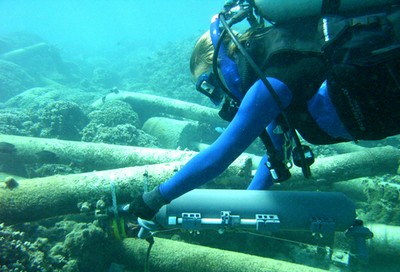UC SANTA BARBARA (US) — A team of researchers has reported results from the broadest worldwide study of ocean acidification—or pH level—to date. — Posted 24 January 2012 on Futurity.Org
![]()
![]()

Graduate student Emily Rivest positions a SeaFET pH sensor in a coral reef off the island of Moorea, in French Polynesia. The grey bottle is used to collect seawater samples for chemical analyses that augment the pH data. (Credit: Anderson Mayfield)
Acidification is known to be a direct result of the increasing amount of greenhouse gas emissions. The University of California, Santa Barbara, scientists used sensors to measure the acidity of 15 ocean locations, including seawater in the Antarctic and in temperate and tropical waters.
A SeaFET pH sensor is deployed underneath approximately 12 feet of sea ice in McMurdo Sound, Ross Island, Antarctica, in October 2010. The black object is the sensor, which is anchored to the ocean bottom using weights. Along the ocean bottom, worms and sea stars are visible. (Credit: Rob Robbins)
As oceans become more acidic, with a lower pH, marine organisms are stressed and entire ecosystems are affected, say the scientists, whose findings are published in the journal PLoS ONE.
One-third of the carbon dioxide released into the atmosphere by human activity is absorbed by the world’s oceans, which makes the waters more acidic and affects marine life.
“We were able to illustrate how parts of the world’s oceans currently have different pH, and thus how they might respond to climate changes in the future,” says Hofmann. “The sensors allowed us to capture that,” says Gretchen E. Hofmann, an eco-physiologist and professor in the ecology, evolution and marine biology department.
The sensors recorded at least 30 days of continuous pH values in each area of the study.
Since the beginning of the industrial revolution, human activities have accelerated the release of carbon dioxide into the atmosphere as carbon dioxide mixes with water. The two molecules combine to become carbonic acid, making seawater more acidic. As billions of molecules combine and go through this process, the overall pH of the oceans decreases, causing ocean acidification.
Acidification limits the amount of carbonate forms in the environment, which are needed by marine invertebrates, such as coral, urchins, snails, and shellfish, to make their skeletons. As the concentration of carbonates decreases in acidified water, it is harder to make a shell. And, the structures of some organisms may dissolve when water chemistry becomes too unfavorable.
“The emerging pH data from sensors allows us to design lab experiments that have a present-day environmental context,” says Hofmann, lead author of the study. “The experiments will allow us to see how organisms are adapted now, and how they might respond to climate change in the future.”
Hofmann researched the Antarctic, where she has worked extensively, as well as an area of coral reefs around the South Pacific island of Moorea, where UCSB has a Long-Term Ecological Research (LTER) project. She also studied the coastal waters of Santa Barbara, in conjunction with UCSB’s Santa Barbara Coastal LTER. The research team provided 30 days of pH data from other ocean areas around the world.
The researchers found that, in some places such as Antarctica and the Line Islands of the South Pacific, the range of pH variance is much more limited than in areas of the California coast that are subject to large vertical movements of water, known as upwellings.
In some of the study areas, the researchers found that the decrease in seawater pH being caused by greenhouse gas emissions is still within the bounds of natural pH fluctuation. Other areas already experience daily acidity levels that scientists had expected would only be reached at the end of this century.
“This study is important for identifying the complexity of the ocean acidification problem around the globe,” says co-author Jennifer Smith, a marine biologist with Scripps.
“Our data show such huge variability in seawater pH, both within and across marine ecosystems, making global predictions of the impacts of ocean acidification a big challenge.”
Todd Martz, a marine chemistry researcher at Scripps Institution of Oceanography at UC San Diego, developed the sensor. “When I arrived at Scripps, we re-engineered my prototype design, and since then I have not been able to keep up with all of the requests for sensors,” says Martz.
“Because every sensor used in this study was built at Scripps, I was in a unique position to assimilate a number of datasets, collected independently by researchers who otherwise would not have been in communication with each other.
“Each time someone deployed a sensor, they would send me the data, and eventually it became clear that a synthesis should be done to cross-compare this diverse collection of measurements.”
The team notes that the Scripps sensors, called “SeaFET” and “SeapHOx,” allow researchers to continuously and autonomously monitor pH from remote parts of the world, providing important baselines from which scientists can monitor future changes caused by ocean acidification.
Despite surveying 15 different ocean regions, the authors noted that they only made observations on coastal surface oceans, and that more study is needed in deeper ocean regions farther away from land.
In addition to Hofmann, Martz, and Smith, co-authors include additional researchers from Scripps; the Monterey Bay Aquarium Research Institute; Stanford University; UC Santa Cruz; and Stazione Zoologica Anton Dohrn in Naples, Italy.
Funding for instrument development and related field work came from several sources, including the National Science Foundation, the David and Lucile Packard Foundation, the University of California, the Gordon and Betty Moore Foundation, the Nature Conservancy, the WWW Foundation, Scott and Karin Wilson, the Rhodes family, and National Oceanic and Atmospheric Administration.
Posted on Futurity.Org Earth & Environment.
More news from UC Santa Barbara: www.ucsb.edu/news-topics